oscarbaechler@gmail.com
Check out my art, y'all. Mostly regular sketches, with the occasional polished piece.
12/29/08
Thanks, white Christmas!
oscarbaechler@gmail.com
12/21/08
The next generation of the gaming market.
oscarbaechler@gmail.com
12/13/08
Alien update

oscarbaechler@gmail.com
12/10/08
The 100-pronged structure attack
12/8/08
State of the Union
oscarbaechler@gmail.com
12/6/08
First half of sketchbook, best-of
Really quick, here's some thoughts on my sketchbook process, which can differ hugely from artist to artist.
•I use 11" by 14" Cachet acid free sketchbooks, which are bound in black hardcover rather than spiral. I like them because they're highly protected since they've got spines and thick covers, which means they'll be protected years from now. I like the large format (but not a hugely ridiculous format) because it's the largest format to fit in a backpack or totebag, and I won't kill people on the bus by whipping it out.
•I start by dating the inner cover. This particular sketchbook is dated "November 3, 2008...One day to the election!!!"
•I write "FRONT" on the inside cover as well. I've had numerous sketchbooks that I accidentally start from both ends.
•I then write a list of subjects on the inside cover, as a way to avoid artist's block. I find that when I don't feel like drawing, I can just look at this arbitrary list of subjects and just pick something, then force myself to draw that. Here's the current list:
---life drawing (people on the bus)
---Head (as you'll see, I do this one way too much)
---Full body
---Gestures
---MONSTERS!
---Abstract
---New Media
---Write
---Arbitrary line of action (this is a technique I developed, in which I draw any sort of squiggly line, then start attaching a person to it. Very organic!)
---RPG races
---RPG character (By "RPG races/character" I'm referring to an old favorite for inspiration of mine. I'm frequently creating characters for D&D games and such, and also have several long-term RPGs I've been designing myself. So even if I don't feel like drawing a person on the street or random fantasy crap, it feels good to draw my characters, as a way to get in character.)
•Drawing on the bus is an artistic skill in itself. Many people I know gave up on the idea, due to how the bumping, shaking, starting, stopping and embarrassing onlooking crowds discourage good art. But like anything, it just takes a lot of practice. At this point I think my bus habits have been folded into my technique, which has led to a more careful and precise, value-based method in general (albeit at the lack of gestural quality.)
•I also draw primarily using mechanical pencils. Mechanical pencils on a bus? It's like I combined the most erratic and harsh things I could! But similar to drawing on the bus, drawing with mechanical pencil just takes time. I also have a specific recommendation if you're drawing with mechanical pencil, and need a way to avoid the harsh, sharp, paper-indenting quality it's usually associated with. To draw gently with mechanical pencil, I recommend using training wheels by overextending your lead, even to around an inch long. What will happen over time is that you HAVE to start drawing softly, or else your lead breaks. over time you'll develop a soft touch, and you'll also find that you can increase or decrease your line weight by increasing or decreasing the length of your lead. Once you master these things, you've got two luxuries: first, you'll never be choosing between short, stubby old pencils and long new pencils. Second, you won't have to sharpen any more. Give it a shot, eh?
•Lastly, I mark the final page of my sketchbook with the date it was finished. The theory is to get better at filling it up faster every time.
And now for the point of this post. With the last sketchbook I finished, the whole time filling it up I kept planning to post the best stuff on this blog, and make it a regular habit. Unfortunately, by the time I finished it, there was too must stuff to put up. Do you have any idea how boring and time-consuming it is to scan stuff? Blah! I'd rather be drawing.
So with my current sketchbook, I decided to post my stuff at the halfway point, as a way to cut the workload in half. So here you are, the first half of my November 3rd sketchbook. These drawings were my favorites of this half, although I had to nix a few excellent (but work-related) sketches. Here goes!
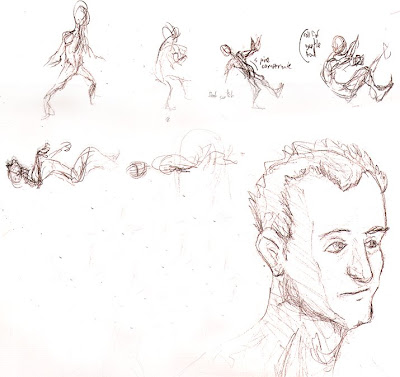 This was two things: some quick gestures for a death animation, and a decent head. One problem I've been running into is that I draw heads WAY too much. It's my favorite part of anatomy, and also the part of anatomy I'm most comfortable with. A lot of this translates into my favorite parts of 3D: facial rigging. I also recently created an in-house head generator to mass produce avatar options, and thus have been in a mood of recording different facial features.
This was two things: some quick gestures for a death animation, and a decent head. One problem I've been running into is that I draw heads WAY too much. It's my favorite part of anatomy, and also the part of anatomy I'm most comfortable with. A lot of this translates into my favorite parts of 3D: facial rigging. I also recently created an in-house head generator to mass produce avatar options, and thus have been in a mood of recording different facial features.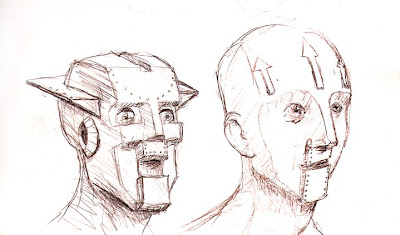
I drew these robot heads on a trip up to Bellingham, WA to help my brother move.
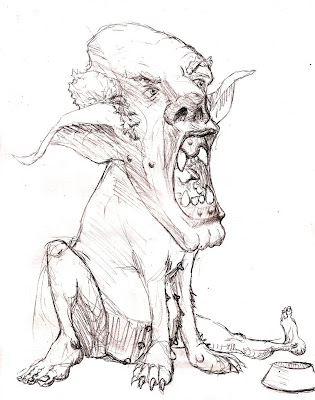
Also drawn on my way to Bellingham. The nipples were my brother's idea.
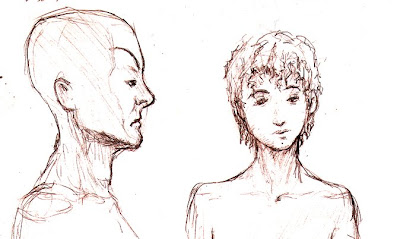
More heads, trying to get a handle on different facial features, such as "Pink Flamingos" eyebrows and a more protruding lip tubercle.
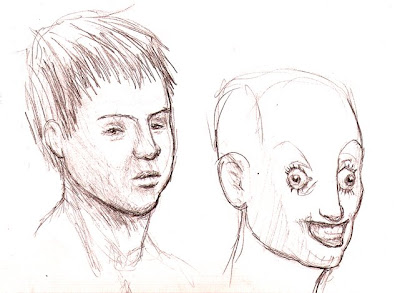
More heads, studying mongoloid features and skeletally stretched skin.
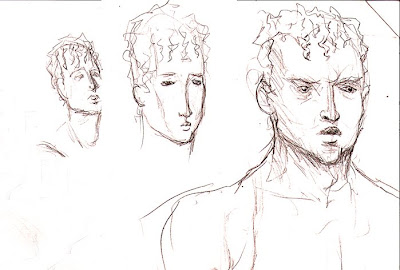
MORE heads, studying what I think of as Greek/English features: low noses, small pouty mouths, and smooth zygomatic processes.
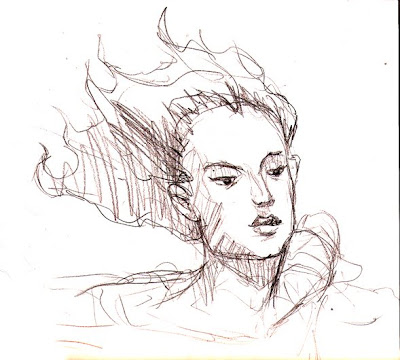
I was trying to recreate what I think of as "Waterhouse Chin," referring to the recurring muse of John William Waterhouse's paintings, most famously seen in his masterpiece "Lady of Shalott." It's partially due to the upward tilt of the head, and partially due to the square jaw offsetting otherwise feminine features.
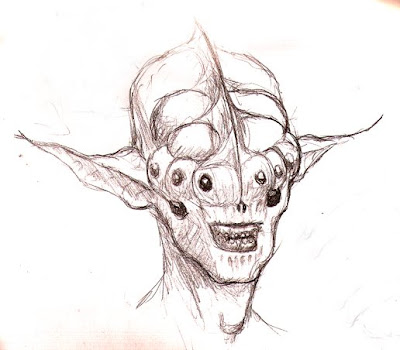
My favorite yet! I like that I retained some human qualities in this, and although I went waaay off the "realism" cliff, I think I maintained a realistic anatomical bone structure in this.
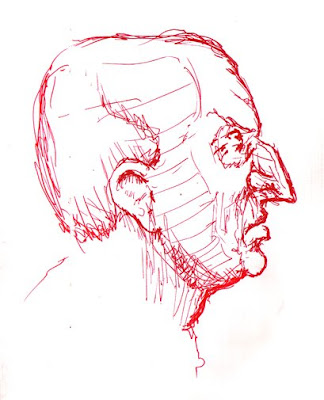
Another random head, with my most common "alternative media" of pen. Considering this was drawn from imagination, I felt happy with how realistic it turned out.
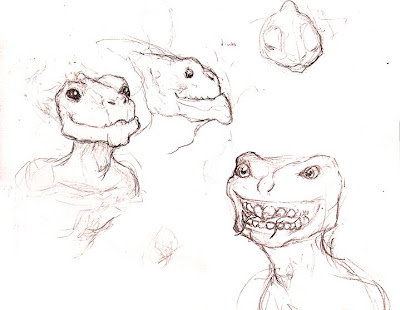
Toying around with the anatomy of an alien species...I'm going for two tongues (the main aberrational feature), broad, short heads, lizard/dinosaur features, and semi-permanent wide eyes and grins. Still needs some work, IMHO.
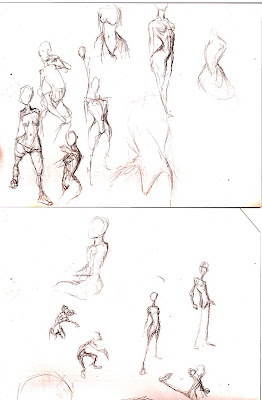
Some gestures and studies of torsos. I think I was feeling guilty about drawing nothing but heads.
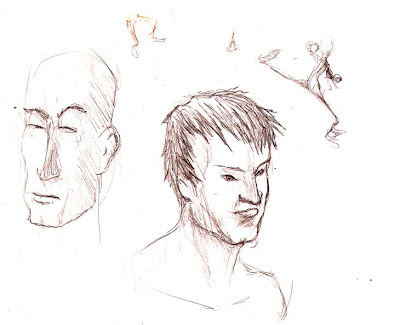
Aaaaand lastly, some more heads and a gesture drawing.
Here's hoping the second half of this sketchbook was as fun as the first.
www.oscarts.org
oscarbaechler@gmail.com
10/15/08
An art history hobby project: six degrees of mentor separation
I'm currently reading a book on Gil Elvgren, who is arguably the greatest pin-up artist of the golden age of pin-ups. The nature of the golden age of pin-ups is that the genre worked side by side with the golden age of illustration, and in the section on Gil Elvgren's influences and contemporaries, it does in fact feature works by several of my favorites; Andrew Loomis (IMHO the greatest teacher by publication in representational and figurative art history) is prominent, as is the buzzword artist of the illustration genre, Norman Rockwell. It's also worth noting in this chain that Loomis is listed as a primary influence of Alex Ross.
One thing I can most definitely say for Andrew Loomis is that, in his book "Creative Illustration," he credits his major influences. Principle among them is Howard Pyle, and he reprints a document of Pyle's which meticulously outlines the exact scientific nature of how light works. Howard Pyle's paintings might not have been the most beauteous of the age (certainly nothing to scoff at though) but he ended up with a much greater influence than his contemporaries because of his contribution to artistic education.
Now the question arises: who taught Pyle? A quick glance over Wikipedia will show that artists are frequently documented with their noteworthy students, but less frequently with their noteworthy teachers. And more important than Howard Pyle, who can trace an artistic lineage all the way back to someone like Da Vinci? The next important idea (especially in terms of Pyle and Loomis, who specifically published as a form of teaching) is whether an artist was directly mentored by another artist, or just intensively studied them. Especially in our modern world, resources needed to STUDY an artist are legion, but it's rare to directly apprentice under James Bama, Alex Ross, or similarly impressive name-drops. That is, unless you pay out the ass for animationmentor.com's resumé of Lucasarts and Pixar veterans. As Jimi Hendrix said, let me stand next to your fire.
That being said, I think that due to technological proliferation (whether it be the ease of internet or revolution of industrialized printing presses) at around 1910 or so, it became increasingly plausible for a young artist to "study under" a historic artist simply by examining his works and artifacts. Alex Ross is the greatest example of this, especially with him listing Andrew Loomis as an influence. Did he study under Andrew Loomis? Technically no, but he was part of a generation whose realistic artists undoubtedly owned all of Loomis' books. Loomis, lacking mass produced instructional texts, represents a generation that needed hands-on instruction. Theyir primary methos of learning were apprenticeship, their local gallery, and (Leonardo's favorite) learning through good ol' fashioned study of nature.
The modern generation is different in my opinion. For one thing, we have a vast population of talented artistic teachers who yell at us to go study nature; I think we're more likely to do so just because it's said much more frequently. Second, we can tailor who we WISH were our influences, learn about these tailored influences with the ease of a google image search. I recently saw my first ever Walter Langley painting through the randomness of the internet. I instantly fell in love, looked up a bunch of his stuff, and plan to regularly return to his paintings in hopes he rubs off on me. Even doing this through the library is easier, as the internet lets me manually check out Langley-related books in a moment. And thirdly, the modern artist is different because we exist with the luxury of "Tutorial Culture." Do you want to be a matte painter? Go explore www.3dm3.com and, with a few days of tutorial crunching, you'll be closer. Want to be a rigger? Go to www.rigging101.com and, with a few days of tutorial crunching, you'll be closer. Want to find out who's way better than you, then ask them questions about where to go next? Go to CGtalk and explore their "best of" section--expect a major blow to your self esteem and a major step forward in your understanding of representational/cartoon art.
But the question still remains...who can trace their artistic family tree back to Leonardo Da Vinci? Can you?
oscarbaechler@gmail.com
10/3/08

You know what I love? Starting personal projects, then saying "ooh, look over there!" and starting a new project.
Such as this photoshop painting! I wanted to do a high-detail caricature in the vein of John K. Although it's colorized, it hasn't actually been colored. I think this has some potential, so long as I don't get excited about some new thing I started.
www.oscarts.org
oscarbaechler@gmail.com
9/14/08
First off, Blender is awesome. The more I use it the more I like it, and I feel like I'm completely over that "new program" hump of learning. Anything beyond this point is advanced stuff, such as masterful rigging, nodal interface, and Python scripting. My goal is to learn python scripting, because aside from its uses with blender, it now transfers over to Maya and actual programming. That's one issue with MEL--if you're not in Maya, what's the point?
Second off, speaking of new programs, I've been learning MaPZone for procedural texturing. I've done a little of this in Maya's hypergraph, but MaPZone truly knows what it's doing. Furthermore, procedural texturing is truly an art unto itself--how do you make a texture when you're not allowed to simply add pixels by hand? Try it out, it's free! www.mapzoneeditor.com
Thirdly, I've been handling a new field for me--2D orthographic buildings. It's a new frontier for me, because I'm not only focused on character stuff usually, but it's also from the classic pixel RTS/RPG top down view.
And lastly, since I ought to post something worth seeing, here's a WIP for an idea I wanted to explore. It's essentially a huge, two-headed war tortoise, which will hopefully have that gargantuan feeling of an oliphant from LotR. Check it out!


Next big chunks are the head and anatomically correct feet, and after that I'm going to be modeling all the little detail stuff.
www.oscarts.org
oscarbaechler@gmail.com
7/8/08
Happy Birthday dad!!!
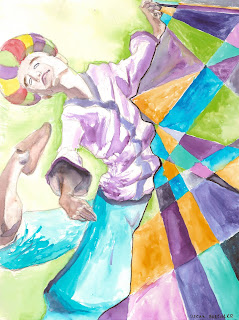
oscarbaechler@gmail.com
6/30/08
Thoughts on Blender
oscarbaechler@gmail.com
6/17/08
My movie to-do list
The problem with AFI's top 100 films is that it's too mired with dogma. Some secret panel of men with long white beards tell us what's good, often when historical significance or precedence is all a film has going for it (Snow White's on it, not because it's the best animated feature, just 'cause it was the first.)
But combine the two, and you get an excellent cross-reference of the gems of our cinema landscape. So I'm going to get back on the wagon and make the big push to round out AFI's top 100, as well as the first 100 of IMDB's 250. Here's what I've got left:
IMDB
1. Paths of Glory
2. M
3. The Lives of Others
4. Double Indemnity
5. Eve
6. Spirited Away
7. Downfall
8. Metropolis
9. Modern Times
10. Rebecca
11. Life is Beautiful
12. Some Like it Hot
13. City Lights
14. The Seventh Seal
15. The Elephant Man
16. Touch of Evil
17. Once Upon a Time in America
18. Kramer vs. Kramer
19. The Great Dictator
AFI
1. Some like it hot
2. African Queen
3. The Grapes of Wrath
4. Bonnie and Clyde
5. High Noon
6. It happened one night
7. The Best Years of our Lives
8. Double Indemnity
9. West Side Story
10. Birth of a Nation
11. A Streetcar Named Desire
12. Butch Cassidy & Sundance Kid
13. Philadelphia Story
14. From Here to Eternity
15. Mash
16. Stagecoach
17. Network
18. An American in Paris
19. The French Connection
20. Wuthering Heights
21. The Gold Rush
22. City Lights
23. The Wild Bunch
24. Modern Times
25. Giant
26. Duck Soup
27. Mutiny on the Bounty
28. Frankenstein
29. The Jazz Singer
30. My Fair Lady
31. A Place in the Sun
32. The Apartment
33. The Searchers
34. Bringing up Baby
35. Yanky Doodle Dandy
I'm watching All About Eve right now, which is freakin' terrific. In some ways, the art of the evil woman has been lost. Sure, there's still female bad guys, and catty teen girls are frequent villains. However, that truly lifelike, catty, two-faced type of the finer sex's uglier side is a rarely well-portrayed character. For more great films with this, I recommend The Manchurian Candidate, Sunset Boulevard and Singin' in the Rain.
http://en.wikipedia.org/wiki/AFI%27s_100_Years..._100_Movies
http://www.imdb.com/chart/top
www.oscarts.org
oscarbaechler@gmail.com
6/9/08
I have a confession...
For those of you not in the know, stumbleit.com has you fill in your user's interests, then provides you with a time-sucking firefox button, which will randomly pull up pages relating to your interests. Here's one I just came across, for all you mac users:
http://www.opensourcemac.org/
But the main website you need to check out is:
www.stumbleit.com
Seriously. It'll replace your current "web 1.0" internet addiction in a heartbeat.
www.oscarts.org
oscarbaechler@gmail.com
6/5/08
More new art!

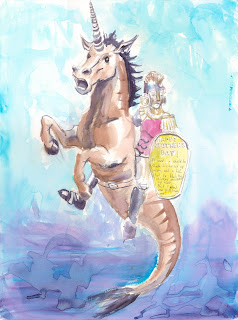
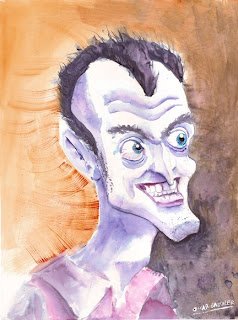
oscarbaechler@gmail.com
6/4/08
New art
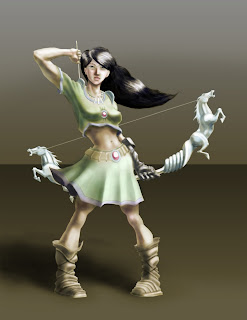
oscarbaechler@gmail.com
5/9/08
Blender 3D
www.oscarts.org
oscarbaechler@gmail.com
4/25/08
11 Second Club WIP #2
oscarbaechler@gmail.com
4/24/08
Phantom Menace vs. Ratatouille: the importance of choice
oscarbaechler@gmail.com
4/18/08
On facial animation
oscarbaechler@gmail.com
4/8/08
4/3/08
Experimental animation's true calling
oscarbaechler@gmail.com
3/23/08
Neverwhere review
oscarbaechler@gmail.com
3/21/08
The top five list of...uh...lists.
3/16/08
Auditory philosophy of the demo reel.
3/14/08
Screen capture software
Copernicus: On the plus side, this program's free to use, and it's also available for mac. Unfortunately, the quality of the output is pretty bad, and you can't really mess with the settings too much. A lot of the captured frames seem to be blended between camera moves, and therefore get some weird artifacting. But, on the other hand, it pumped out a file successfully.
Camtasia: This was recommended to me by dudes at www.strutyourreel.com, and it's once again got some ups and downs. For one, there's no mac version, but that's pretty minor; I just rebooted in windows and installed it there instead. For another thing, it's only a 30 day trial. Bummer. And lastly, although it pumped out a native format video file (.camtec) it took me a couple tries to get the file format I wanted. However, the ends justify the means, and Camtasia's final output was great. The quicktime file I ended up with is great quality, and I look forward to replacing the ugly, way-too-fast copernicus footage.






